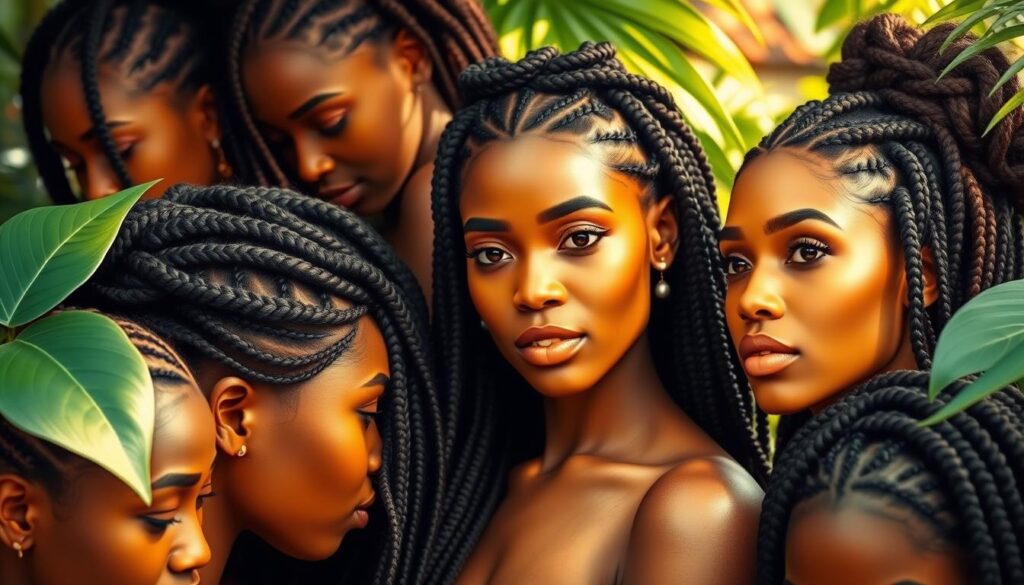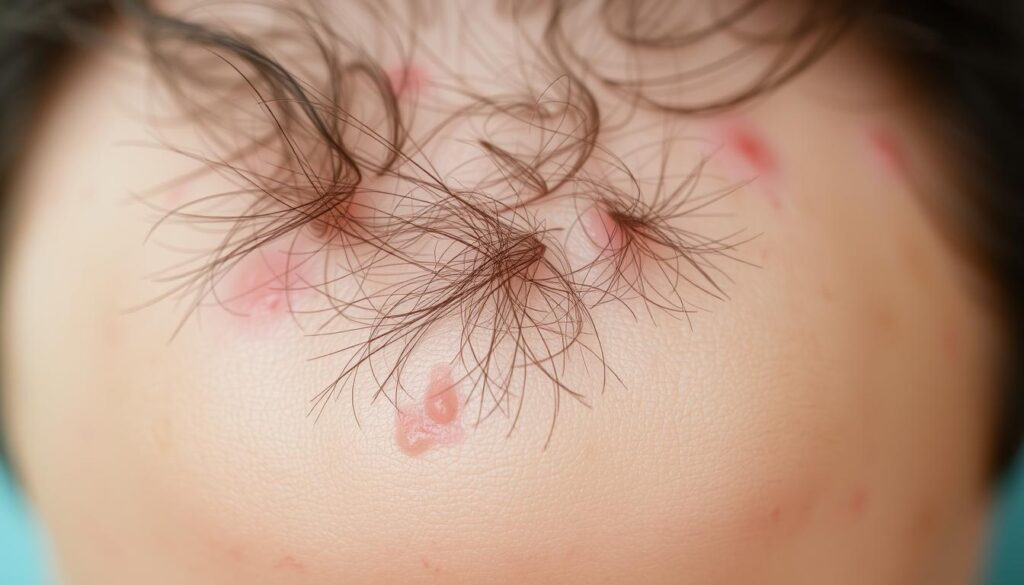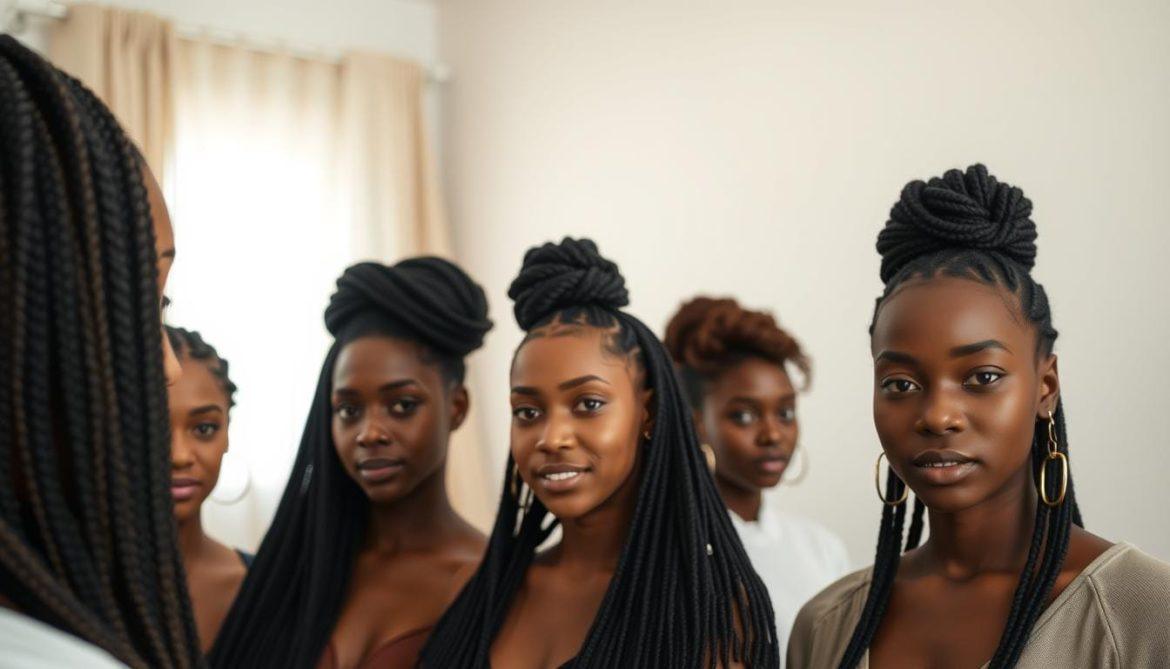Ever feel like your strands are stuck in a cycle of split ends and frustration? You’re not alone. Many of us dream of lush, healthy lengths but struggle with daily wear and tear. That’s where the magic of intentional styling comes in—a way to nurture your crown while letting it thrive.
Think of these looks as a cozy blanket for your natural texture. By reducing combing, heat, and exposure to harsh elements, you give your strands room to breathe and grow. Less manipulation means fewer broken ends, and that’s where the real progress happens.
Whether you love chunky braids, sleek wigs, or chic twists, there’s a low-maintenance option for every vibe. This guide will walk you through the best techniques, from choosing styles to mastering upkeep. You’ll even get pro tips on products that keep your edges smooth and your scalp happy.
Key Takeaways
- Low-manipulation designs shield strands from daily stress and environmental damage
- Consistent use of these methods can lead to stronger, longer natural texture over time
- Popular options include box braids, faux locs, and silk-lined headwraps
- Proper installation and moisturizing routines prevent tension-related thinning
- Pair styles with quality oils and creams to maintain scalp health
Understanding Protective Styles
Your journey to stronger strands starts with smart choices. Protective styling isn’t just about aesthetics—it’s a strategic approach to safeguarding your crown. By tucking away vulnerable ends and minimizing friction, these methods create a safe space for your texture to flourish.
Definition and Importance
A true protective style keeps your ends hidden while avoiding tension. Think braided updos or twists that don’t pull at your roots. This approach matters because daily combing and brushing weaken strands over time. Less handling means fewer split ends and breakage.
How They Reduce Damage and Promote Growth
When your texture stays tucked, it avoids sun, wind, and pollution. Braiding techniques with gentle tension protect delicate edges from snapping. Proper installation prevents traction alopecia—a common issue from overly tight styles.
Consider these essentials:
- Silk-lined headwraps reduce nighttime friction
- Loose buns keep ends moisturized and contained
- Interlocked twists distribute weight evenly across the scalp
Choosing the right method lets your strands thrive without constant styling stress. It’s about balance—protecting while letting your natural beauty shine through.
Benefits of Protective Hairstyles for Hair Growth
Imagine giving your strands a vacation from daily wear. These styling methods act like armor, shielding your crown while creating ideal conditions for resilience. The magic lies in their dual role: preserving hydration and preventing mechanical stress.
Minimizing Breakage and Retaining Moisture
Constant brushing weakens delicate ends. By keeping strands tucked away, you eliminate 60-80% of routine combing. This simple shift lets your natural texture retain length instead of snapping off.
Sealed styles like braids or twists trap hydration better than loose strands. Apply leave-in conditioners before installation—products with shea butter or argan oil work wonders. Your ends stay nourished for weeks instead of drying out daily.
Reducing Scalp Tension and Environmental Stress
Overly tight updos can damage follicles over time. Properly installed designs distribute weight evenly, letting your roots breathe. This balance prevents traction alopecia while shielding from UV rays and pollution.
| Product Type | Key Benefit | Usage Tip |
|---|---|---|
| Lightweight Oils | Prevent dryness | Apply to edges twice weekly |
| Scalp Serums | Reduce itching | Use dropper for targeted care |
| Silk Scarves | Limit friction | Wrap before bed |
Wind and humidity cause frizz and tangles. Secured styles act like a barrier, keeping your strands smooth. Pair them with water-based sprays for lasting softness without buildup.
Preparing Your Natural Hair for Protective Styling
Your crown deserves VIP treatment before any styling marathon. Think of this phase as laying a strong foundation—skipping these steps risks undoing all your growth efforts. Proper prep ensures your strands stay resilient, moisturized, and ready to thrive under wraps.
Pre-Styling Care: Trimming and Deep Conditioning
Start with sharp shears. Removing split ends creates a clean canvas, preventing hidden damage from worsening. Experts like Tiffany Walker recommend trimming every 8-12 weeks. Follow with a sulfate-free shampoo to gently cleanse without stripping natural oils.
Next, lock in moisture with a deep conditioning treatment. The Rosemary Mint Strengthening Masque works wonders—its peppermint oil stimulates blood flow while proteins reinforce strands. Apply heat for 15 minutes using a thermal cap to boost absorption.
Essential Washing and Moisturizing Steps
Detangle gently using a wide-tooth comb on damp sections. Divide your crown into four parts, working from ends to roots. This method reduces snap-offs and stress.
Layer hydration like a pro:
- Spray a water-based mist to dampen strands
- Apply leave-in conditioner focusing on porous ends
- Seal with light oil (jojoba or grapeseed)
This routine creates a moisture shield that lasts weeks. Brands like Mielle Organics offer targeted products that nourish without weighing down your texture. Remember: well-prepped strands mean fewer snags during braiding or twisting.
Varieties of Protective Styles for Natural Hair
Your natural texture deserves options that work as hard as you do. From timeless classics to fresh innovations, today’s styling choices blend practicality with personality. Let’s explore designs that keep ends secure while letting your creativity shine.

Exploring Braids, Twists, and Buns
Box braids remain a go-to for their versatility. Celebrities like Ciara rock them in sleek jumbo sizes or delicate micro versions. Cornrows offer a flatter profile—perfect under wigs or hats. For softer looks, Senegalese twists with marley hair mimic natural coils beautifully.
Twist-outs and buns thrive on simplicity. A high puff using satin scrunchies protects ends while showing off your shape. The key? Keep tension light and edges moisturized with oils like Jamaican black castor.
Wigs, Extensions, and Locs Options
Want daily versatility? Clip-ins and crochet braids let you switch looks without commitment. Rihanna’s bold faux locs prove synthetic options can feel luxe. For low-maintenance glam, try glueless wigs with adjustable bands—they’re kinder to your edges.
Traditional locs versus faux versions? Real ones demand patience but last years. Temporary styles like goddess locs use kanekalon hair for instant bohemian vibes. Pair either with edge control gels for polished roots.
Whether you choose twists for their reusability or extensions for length play, prioritize gentle installation. Brands like Xpressions offer pre-stretched braiding hair that reduces styling time. Remember: the best style aligns with your routine while letting your crown rest.
Tips & Tricks for Maintaining Your Protective Style
Want your chosen style to last while keeping your crown healthy? Smart upkeep makes all the difference. Let’s break down daily and nightly habits that preserve both your look and natural texture.
Nighttime Care: Silk Pillowcases and Scarves
Cotton pillowcases create friction that roughs up strands. As stylist Tiffany Walker notes: “Silk reduces tugging by 70% compared to cotton.” Wrap your crown with a satin scarf or use silk-lined caps to keep edges smooth.
Secure loose braids or twists with soft bands. Avoid tight elastics that dent your style. This simple switch helps prevent frizz at the roots.
Daily Product Use and Hydration Techniques
Hydrate without weighing down your strands. Mist with water mixed with aloe vera juice, then apply Rosemary Mint Scalp & Hair Strengthening Oil. Focus on dry areas like ends and edges.
| Product Type | Best For | Application Tip |
|---|---|---|
| Lightweight Oils | Sealing moisture | Use 2 drops on fingertips |
| Leave-In Sprays | Midday refresh | Spritz 6 inches away |
| Edge Control Gels | Style preservation | Apply to clean edges |
Minimize morning touch-ups. Finger-comb instead of brushing to maintain your design. Cleanse your scalp weekly with diluted apple cider vinegar to remove buildup.
Consistent care keeps your style fresh for weeks. Pair these steps with gentle handling, and you’ll notice stronger, shinier strands over time.
Troubleshooting Common Issues with Protective Styles
Even the best-laid styling plans can hit snags. Let’s tackle frequent challenges head-on so your strands stay healthy beneath their temporary armor.

When Your Crown Rebels: Itchiness and Buildup
That persistent tickle? Often caused by dry scalp or product overload. TGIN’s Tea Tree & Peppermint Scalp Serum cools irritation instantly. For stubborn residue, mix clarifying shampoo with water in a spray bottle—target roots without disturbing your style.
Too-tight installations worsen flakiness. “If your forehead feels tight, speak up immediately,” advises stylist Laila Johnson. Loosen braids near edges using a tail comb’s handle.
Safeguarding Delicate Zones
Tension alopecia often starts subtly. Notice baby hairs thinning? Swap tight elastics for silk scrunchies. Apply castor oil to edges nightly using a soft brush—this strengthens fragile strands.
Key prevention steps:
- Limit style duration to 6-8 weeks max
- Massage scalp 3x weekly to boost circulation
- Choose human hair extensions over heavy synthetics
Breakage often signals hidden damage. Schedule trumps every 10 weeks. If styles feel heavy, opt for shorter lengths or lighter braiding hair. Your crown thrives when you balance beauty with compassion.
Styling Ideas and Creative Protective Looks
Your crown becomes a canvas when classic techniques meet fresh perspectives. Today’s styling landscape lets you honor tradition while bending the rules—think geometric braid patterns or unexpected texture combinations.
Box Braids, Cornrows, and Senegalese Twists
Celebrity stylist Tiffany Walker transformed Zendaya’s red-carpet look with asymmetrical box braids—thicker at the crown, tapering to wisps. Try this by varying braid sizes across sections. Cornrows get edgy when styled in chevron patterns or paired with bead accents.
Senegalese twists shine in metallic ombré shades. Use marley hair for volume, then dip-dye ends in rose gold. For events, gather twists into a high bun secured with decorative cuffs. This dual-purpose look protects ends while turning heads.
Mixing Traditional Looks with Modern Trends
Upcycle your current style in minutes. Convert waist-length braids into a crown-shaped updo using spiral pins. Add ribbon weaves to cornrows for festival vibes. “Layer textures,” suggests Walker. “Pair silky straight extensions with your natural coils at the front.”
Three ways to refresh classics:
- Swap basic buns with space buns using colored scrunchies
- Install feed-in braids with underlayers of loose curls
- Thread pearls through twist-outs for bridal elegance
These innovations prove practicality and artistry coexist. Your strands stay shielded while expressing your evolving aesthetic—no compromise needed.
Incorporating a Healthy Haircare Routine
What if your styling efforts could do double duty? A thoughtful regimen amplifies the benefits of low-manipulation designs. Think of it as teamwork—your chosen style shields strands while daily habits build resilience from root to tip.
Optimal Frequency for Scalp Cleansing and Conditioning
Cleanse every 7-10 days to remove product buildup without stripping natural oils. Experts at Mielle Organics recommend diluted shampoos applied with a nozzle bottle. This targets the scalp while preserving your style’s integrity.
Conditioning isn’t optional. Use water-based leave-ins weekly to maintain elasticity. The TGIN Green Tea Super Moist conditioner works wonders—its lightweight formula penetrates braids or twists without residue.
Three pillars of maintenance:
- Schedule 2-week breaks between styles to assess strand health
- Apply rosemary-infused oils during nighttime routines
- Trim ends every 10-12 weeks to prevent hidden splits
Consistency trumps intensity. Dedicate 15-minute sessions thrice weekly for scalp massages and hydration checks. Track progress with monthly length photos—you’ll spot gains faster than you think.
Your crown thrives on predictability. Pair these steps with quality products, and watch your efforts compound into visible strength and shine.
Conclusion
Your strands thrive when care meets creativity. By choosing styles that shield ends and reduce daily stress, you create an environment where your natural texture can flourish. Remember: proper prep work like trimming split ends and deep conditioning sets the stage for success.
Consistency matters most. Nightly silk wraps preserve edges, while lightweight oils keep scalps balanced. Tackle buildup quickly with diluted shampoos, and never ignore tension—your crown should feel supported, not strained.
Quality products become your allies. A good leave-in conditioner and water-based sprays maintain moisture without residue. Pair these with regular trims to maximize growth potential between styling sessions.
Every day offers a chance to nurture your crown. Whether trying bold braids or sleek buns, let your choices reflect both practicality and self-expression. Growth isn’t just about length—it’s about embracing the journey with confidence.
